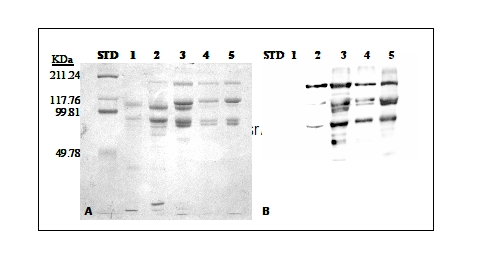Anti-VTG | Sole vitellogenin
AS06 127 | Clonality: Polyclonal | Host: Rabbit | Reactivity: Sole
- Product Info
-
Immunogen: Native vitellogenin purified from plasma of estradiol induced male of Senegalese sole (Solea senegalensis)
Host: Rabbit Clonality: Polyclonal Purity: Serum Format: Lyophilized Quantity: 200 µl Reconstitution: For reconstitution add 200 µl of sterile water Storage: Store lyophilized/reconstituted at -20°C; once reconstituted make aliquots to avoid repeated freeze-thaw cycles. Please remember to spin the tubes briefly prior to opening them to avoid any losses that might occur from material adhering to the cap or sides of the tube. Tested applications: ELISA (ELISA), Western blot (WB) Recommended dilution: 1 : 5 000 on sole serum (ELISA), 1 : 5 000 (WB) Expected | apparent MW: ca. 200 kDa - Reactivity
-
Confirmed reactivity: Senegalese sole, Dicentrarchus labrax (sea bass), Sparus aurata (seabream) Not reactive in: No confirmed exceptions from predicted reactivity are currently known - Application Examples
-
Application example

STD: Protein standard (molecular weights of the proteins are indicated on the left) (1) plasma from male sole (load 0.11 ul of plasma),(2) plasma from vitellogenic female sole (load 0.11 ul of plasma), (3) plasma from estradiol-treated male sole (load 0.08 ul of plasma,(4) VTG precipitate (load 0.83 ul of precipitate),(5) purified VTG (load 2 ul of purified preparation, corresponding to around 0.14 ug and spawning performance in cultured VTG) were separated on SDS-PAGE 7.5% resolving gel, 4% stacking gel. Samples were denatured in SDS and b- mercaptoethanol and treated 4 min 95 oC before loading. Following gel electrophoresis proteinswere transfered to PVDF Membrane (Inmobilon-P, Millipore) for 2 h. Blots were blocked in TBST containing 2% non-fat dry milk. Blots were incubated in primary antibody at a dilution 1: 40 000, followed by incubation with secondary antibodies. goat anti-rabbit HRP conjugated in a dilution 1:2,000) and reaction was developed using chemiluminescence.
- Additional Information
-
Additional information: VTG can be purified using following methodology:
Mañanós et al. (1994). Sea bass (Dicentrarchus labrax L.) vitellogenin. I—Induction, purification and partial characterization. Comparative Biochemistry and Physiology Part B: Comparative Biochemistry, Vol 107 (2): 205-216.
Guzman et al. (2008) Vitellogenin, steroid plasma levels and spawning performance of cultured female Senegalese sole (Solea senegalensis).Gen and Comp Endocrinology 156: 285-297.Additional information (application): The developed VTG ELISA, using these VTG and AbVTG, has been validated for Senegalese sole, sea bass (Dicentrarchus labrax) and seabream (Sparus aurata), which all gave parallel displacement curves in the assay. Probably, plasmas from several other fish species displace parallel and can also be used in the assay, although it has to be validated for each case.
- Background
-
Background: Vitellogen (VTG) is a glucolipoprotein yolk precursor produced by all oviparous animals. This protein is female-specific and its expression is under hormonal control (estrogen). However, in the presence of Endocrine Disrupting Chemicals (EDC's), males can express the VgTG gene in a dose dependent manner. The use of VTG gene expression in male fish can be used as a molecular marker of exposure to estrogenic EDC's.
- Product Citations
-
Selected references: Guzman et al. (2008) Vitellogenin, steroid plasma levels and spawning performance of cultured female Senegalese sole (Solea senegalensis).Gen and Comp Endocrinology 156: 285-297. - Protocols
- Antibody protocols
- Reviews:
-
This product doesn't have any reviews.


